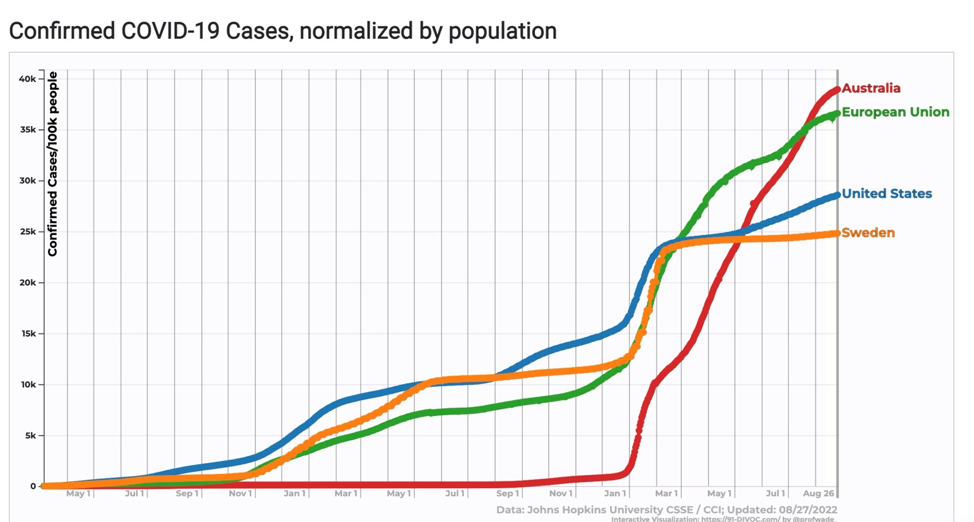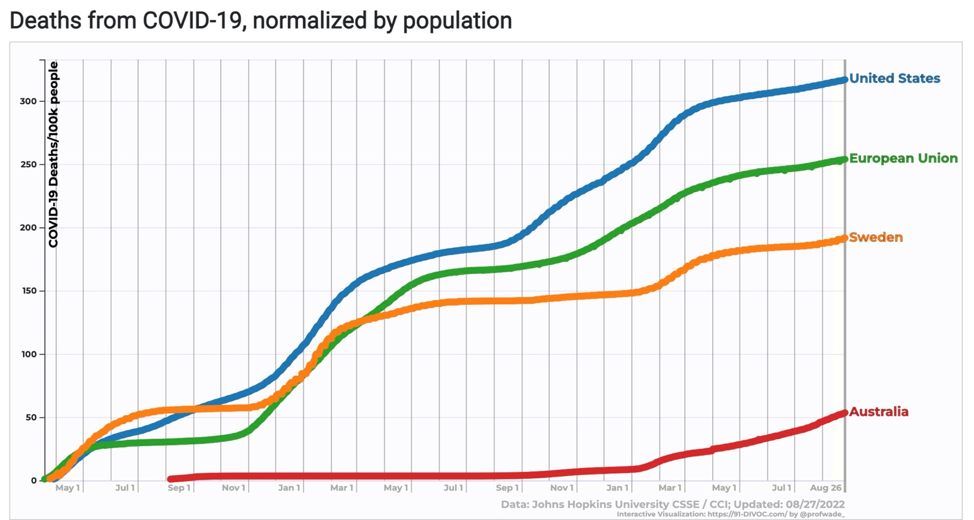A spike in pneumonia cases in December of 2019 in Wuhan, China was quickly found to be caused by a new coronavirus. Coronaviruses usually cause the common cold, but this one could be lethal. It would eventually come to be called Covid, as I will call both the virus and the disease.
Covid was very contagious. Someone with the flu infects, on average, about 1.1 other people. The first estimate for Covid was 2.5. Think of how many times you’ve had the flu, and you can see the problem. What lessened the blow was that Covid is not very lethal. In 2019, about 0.85 percent of the U.S. population died, in 2020 and 2021 it was just above 1 percent, meaning about 0.15 percent probably died of Covid.
The deaths mostly occurred in the older subset of the population. If you were over the age of 80 and got infected, you had a one in six chance of dying. Odds improved dramatically the younger the person. 75 percent of the deaths were people over 65, less than 1 percent under 30.
Experts knew that with these characteristics, the virus was going to spread very rapidly. Most people would probably be infected at some point. It took only one month from its discovery in China to identify the first case in the United States, from a sample collected on January 18, 2020.
The Great Lockdown Experiment
Governments worldwide responded to the Covid pandemic with different levels of authoritarian measures. They used various mixes of forced business closures and personal mandates to try to control the spread. Cases may spike once again in the fall, so we should examine the data to see how those measures fared.
Sweden did basically nothing in terms of governmental mandates. On the other end of the spectrum, Australia had some of the most draconian measures outside of China. Since we can’t rely on the numbers from China, let’s use Australia as the king of lockdowns. We’ll examine the data from Johns Hopkins as compiled here. We’ll compare Sweden to the United States and the European Union as a whole (who arguably had medium-level lockdowns), and Australia.

Oops, Sweden wins. It was a bit surprising to me that the lockdown measures would do much of anything, and they didn’t for the United States or the EU, but apparently Australia was authoritarian enough to at least delay the prediction that most people would get the virus. But wait, aren’t we interested in deaths, not infections?

Vindication of lockdowns? Sweden still looks much better than the United States or EU, but delay certainly did Australia some good. This is not because Australia is isolated in any meaningful way. It has more than 25 million people, and the virus was present. So maybe we should all lockdown to the maximum to avoid an extra 0.15 percent death rate for two years. Costs aside, however, there is a fallacy with this approach.
In all known cases of zoonotic transmission, a virus starts out with its maximum lethality, then mutates to become less lethal and more contagious. This would have been useful information to calm the public during the pandemic, but the experts in the press seemed blithely unaware of that fact, often stating that we don’t know if Covid may mutate to become more virulent. It seems this isn’t something they covered in medical school. Perhaps they were cautious because the virus came from a lab, but it was mostly stitched together from parts of zoonotic origin, and it did end up following the expected course.
Mutations in viruses are extremely low probability events that occur at a rate that appears high because of the many trillions of replication cycles involved. A virus is so small that each cell will have about 10,000 of them before it bursts, and the average infected individual will get somewhere near 100,000 cells infected (you have around ten trillion cells in your body). Time is not a large factor in viral mutation – replication is when mutations happen. It had to infect many millions before mutating into Omicron.
Therefore, if the entire world were to bunker up Australia-style, it would only prolong the agony. Australia’s lockdown allowed them to wait until others accumulated deaths and mutations, then they received a strain that was less lethal but more infectious. So infectious that their lockdown became ineffective. While vaccinations had some effect, the reduced lethality of the strain was much more important. Perhaps this would be a good strategy for a country in case of a very lethal virus, but that would not be very “equitable” towards the neighbors.
Nearly every country in the world enacted authoritarian measures which proved to be useless. Sweden resisted the trend, and the data just flat does not lie – they had fewer infections and deaths than the U.S. or EU.
There never was and there never will be a justification for authoritarianism, not from an infectious disease. If a virus comes along that is more deadly than Covid, there will be no need to order lockdowns. At some point of lethality, people would not go to work or send their kids to school, no police actions necessary. I don’t know exactly what that tipping point may be, 1 percent? 5 percent? It is not my business nor the government’s to dictate.
Our Covid response was such an utter failure that even the CDC had to recognize it. There were plenty of infectious disease and medical experts, probably most, who knew the correct approach – assist the older population with voluntary isolation.
At the governmental level, however, something occurred which made their advice go astray. Perhaps it was risk-averseness, or groupthink. For whatever reason, the data show that nearly every country in the world failed to make the correct policy decisions in response to Covid. The costs are staggering.
If lives had been saved by lockdowns, specious arguments about how to value life could be made. The data show that lives were not saved. What benefit did we get from the multi-trillion-dollar child abusing boondoggle that was our Covid response? Nothing.
*Source: Science Confirms: Lockdowns Don’t Stop The Spread
